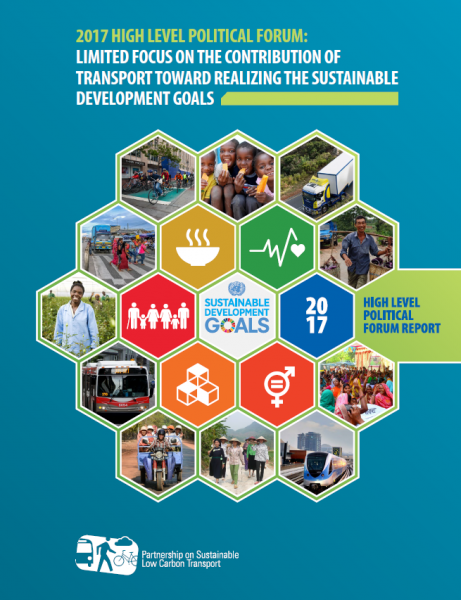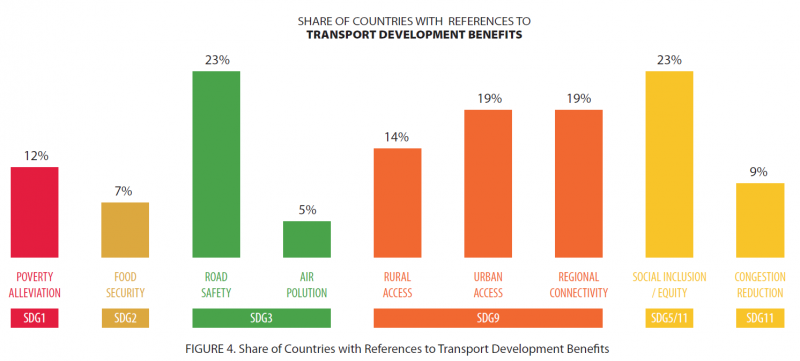2017 High Level Political Forum: Limited Focus on the Contribution of Transport toward Realizing the SDGs
Sustainable transport services and infrastructure are essential to achieving most, if not all, the Sustainable Development Goals (SDGs). Although sustainable transport is not represented by a standalone SDG in the 2030 Agenda, it is mainstreamed in a direct or indirect manner into several SDGs, especially those related to poverty alleviation; food security; access to health services, clean water, education, and employment; gender equality; energy; infrastructure; cities and human settlements; and climate change.
 To better understand how transport is reflected in the SDGs review process under the High Level Political Forum (HLPF), the Partnership on Sustainable, Low Carbon Transport (SLoCaT) has released the report, “2017 High Level Political Forum: Limited Focus on the Contribution of Transport toward Realizing the Sustainable Development Goals”, to review the Voluntary National Reviews (VNRs) submitted by countries, the 2017 SDG Progress Report, the thematic papers submitted by the Major Groups and other Stakeholders (MGoS), and the 2017 HLPF Ministerial Declaration. The report finds that while there is progress on transport’s inclusion in the VNRs and other input to HLPF compared to 2016, there is still much work to be done to establish a structured framework that effectively measures the progress made in the transport sector towards achieving the SDGs.
To better understand how transport is reflected in the SDGs review process under the High Level Political Forum (HLPF), the Partnership on Sustainable, Low Carbon Transport (SLoCaT) has released the report, “2017 High Level Political Forum: Limited Focus on the Contribution of Transport toward Realizing the Sustainable Development Goals”, to review the Voluntary National Reviews (VNRs) submitted by countries, the 2017 SDG Progress Report, the thematic papers submitted by the Major Groups and other Stakeholders (MGoS), and the 2017 HLPF Ministerial Declaration. The report finds that while there is progress on transport’s inclusion in the VNRs and other input to HLPF compared to 2016, there is still much work to be done to establish a structured framework that effectively measures the progress made in the transport sector towards achieving the SDGs.
Key Findings
1. Despite a slight improvement from 2016, gaps remain in reporting on transport and its contribution to sustainable development in VNRs
While only 64% of the 22 VNRs submitted in 2016 contained references to transport (with not all references sustainability-specific), in 2017, 98% of the 43 submitted VNRs have some degree of reference to the transport sector, with 35% of submission giving specific examples to link transport with sustainable development impacts (Figure 1):

Figure 1. Share of countries with references to transport development benefits
An area of progress is that eight countries have set specific transport targets and 11 countries have provided data and figures to report on progress made in the transport sector to achieve specific SDGs. This is an important step towards a more structured review of progress in the transport sector in implementing the SDGs. However, inconsistent data reporting on transport-relevant SDG indicators across the VNRs also shows that the current VNR mechanism lacks the proper structure and framework to guide countries to report in a comparable and coherent manner.
Also, there remains a tendency in many VNRs to merely report on outputs (e.g. kilometers of highways built or kilometers of rail constructed) without demonstrating linkages to broader development goals. At the same time, there is ample evidence of sustainable transport policies and measures in the 2017 VNR countries. It is not fully clear why this progress is not reported in a more substantive manner.
2. The 2017 SDG Progress Report fails to provide a structured framework to measure progress in sustainable transport
The 2017 SDG Progress Report, the second account of where the world stands at the beginning of implementation of the 2030 Agenda, has expanded its references to transport and established linkages between transport and several SDG targets, such as SDG 3.6 (road safety), SDG 3.9 (public health), SDG 7.3 (sustainable energy consumption), and SDG 9.1 (economic development). However, it has not included any information on several key transport-related SDG indicators, such as SDG 9.1.1 (rural access), SDG 11.2.1 (access to public transport), and SDG 12.c.1 (fossil fuel subsidies).
It is apparent that better linkages with organizations and groups (e.g. UN agencies, development organizations, academe) collecting relevant data on transport and SDGs could have improved the coverage of transport in the Progress Report. In the HLPF session titled Leveraging Interlinkages for Effective Implementation of SDGs, Together 2030 called for VNR countries to commit to reviewing all SDGs each year, and SLoCaT would further call for addressing all targets and indicators for each goal under review.
For now, it appears that the VNRs and SDG Progress Reports are two separate processes. This is in part caused by the timing of the VNRs, as the SDG Progress Report is prepared before the VNRs have been submitted. It is advisable that VNRs be submitted with sufficient lead time to both feed into the annual SDG report and to inform discussion throughout the HLPF in the week preceding the ministerial session.
3. Thematic papers by Major Groups and other Stakeholders only gives incidental references on transport
12 sectors of society have formed the Major Groups and other Stakeholders (MGoS) to serve as the main channels for broad participation facilitated in UN activities related to sustainable development. All of the MGoS have submitted sectoral position papers to outline actions that should be taken to achieve the SDGs and enhance well-being of their respective sectors. In addition, the Asia-Pacific Regional CSO Engagement Mechanism and Together 2030, which are civil society initiatives under the HLPF process, also submitted thematic papers. Out of the 14 thematic papers, six have included reference to the transport sector.
Although transport is mentioned in 43% of the thematic papers, it is clear that these references are to a large extent incidental and have not been able to build a structured, consistent linkage between transport and SDGs. The references focus on indicating the importance of transport but fail to provide concrete, sectoral policy recommendations for implementation in the transport sector.
4. The HLPF Ministerial Declaration has yet to include meaningful references and recommendations to scale up actions on sustainable transport
The Ministerial Declaration of the 2017 High-Level Political Forum on Sustainable Development gives very brief references to transport’s role in providing access and the importance of maritime transport and trade. These brief references to transport do not effectively outline the critical role of transport in addressing the overarching themes of the 2030 Agenda on poverty alleviation, food security, and leaving no one behind. Nor do they provide any guidance to governments on how to take action in the transport sector for the specific SDGs under discussion in the 2017 HLPF.
Conclusion
We believe the HLPF process was set up to facilitate the sharing of experiences to accelerating the implementation of the 2030 Agenda. We believe it should also be a tool to mobilize multi-stakeholder support for the implementation of the SDGs. The VNRs, SDG Progress Report, MGoS thematic papres and the Ministerial Declaration deal with this guidance mostly in a general and seemingly haphazard manner, and sector related information, including for the transport sector, is often present in a cursory and qualitative manner. This very much limits the use of the HLPF process as a tool to inspire and guide other countries in taking greater sector-based action in support of the targets set by the SDGs. Thus, we suggest more specific guidelines for sectoral reporting in the HLPF process (as echoed in the HLPF 2017 Interlinkages session by the Centre for Policy Dialogue, among others). Finally, we underscore the need to incorporate inputs from a broader set of stakeholders in the VNRs, SDG Progress Report and the Ministerial Declaration to make these outputs more informative, comprehensive, representative and effective.
The full report on HLPF 2017 is available here.
Supporting matrix on transport references in VNRs
In support of this assessment, SLoCaT has developed a matrix to assess countries’ references to two transport modes, seven transport sub-sectors, and 21 transport policy measures in the VNRs, based on the Avoid-Shift-Improve framework. The assessment also considers whether these transport references are made in relations to nine different sustainability-related impacts, including poverty alleviation, food security, social inclusion and equity, urban access, rural access, regional connectivity, road safety, congestion reduction, and air pollution/ public health. A binary assessment is also made on the references to the four SuM4ALL objectives.
The supporting matrix is available here.
A blog on the interim results of SLoCaT’s anaysis on HLPF 2017 was posted on the SDG Knowledge Hub.